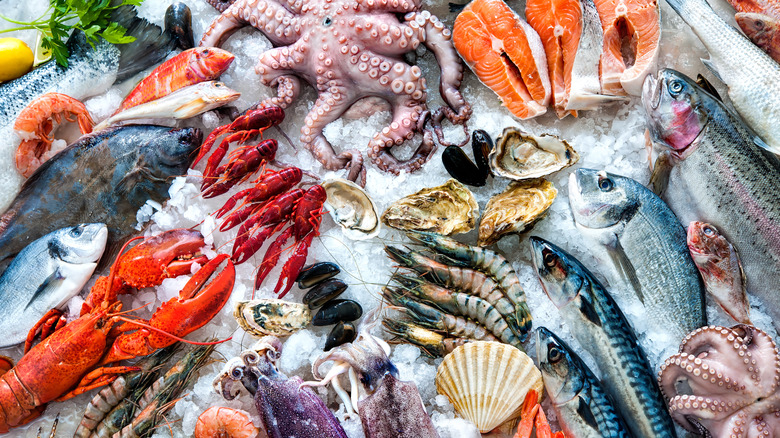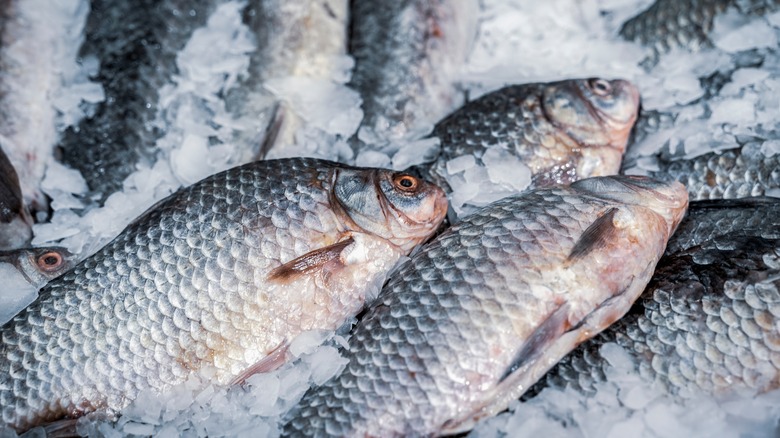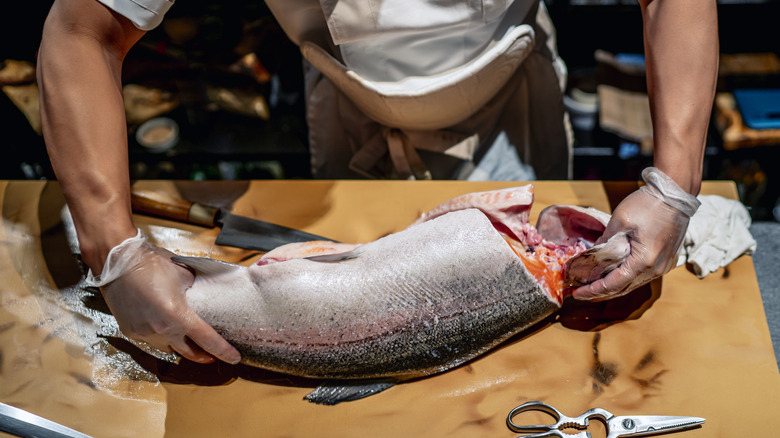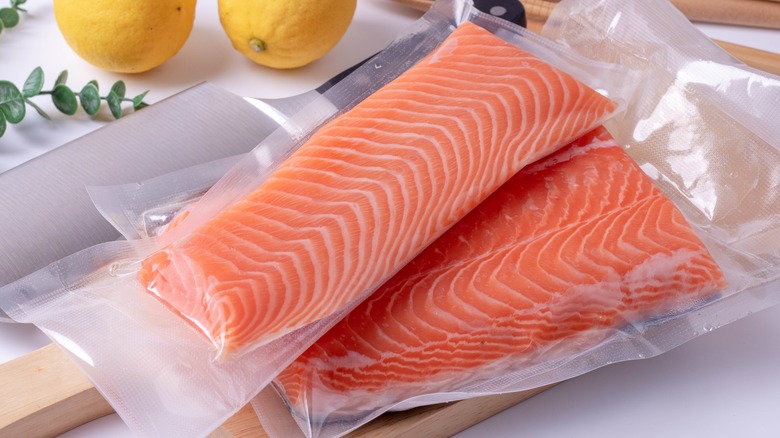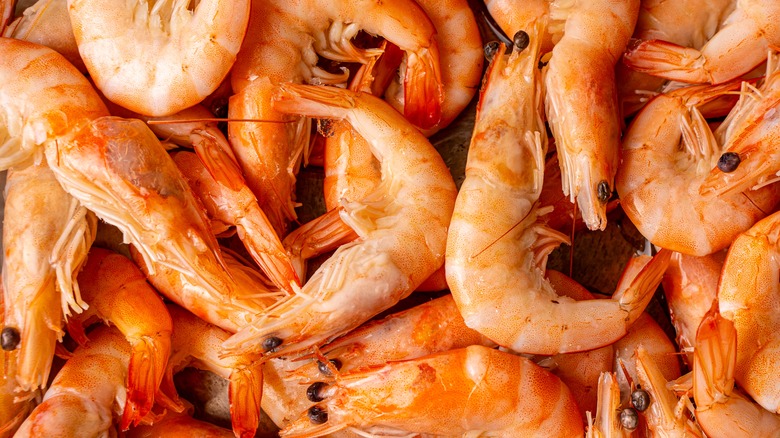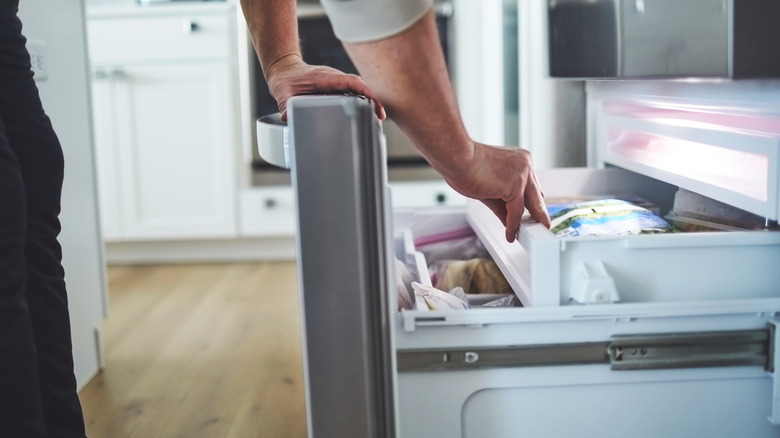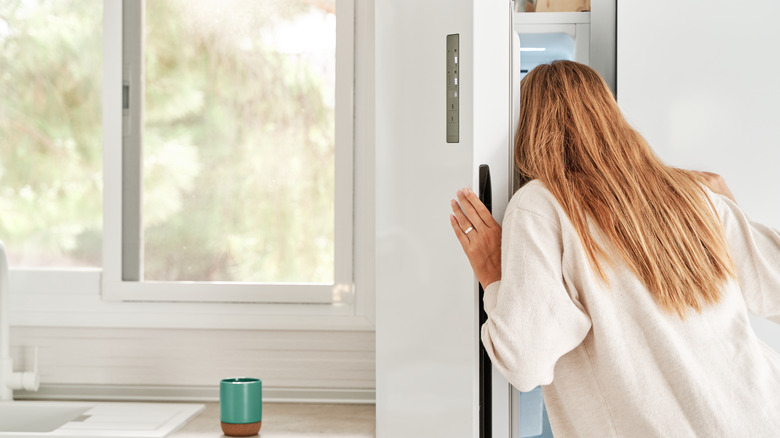8 Common Mistakes Chefs Say Everyone Makes When It Comes To Freezing Seafood
Fresh seafood spoils quickly, to the point that the USDA advises against refrigerating fish and shellfish for more than two days. If you're not going to prepare your favorite seafood recipe within this short window of time, it's best to freeze it for later use. While freezing can significantly extend its shelf life, it must be done correctly in order to ensure both quality and safety. Seafood can easily develop freezer burn and ice crystals, both of which can have a negative effect on its flavor and texture.
Home chefs often fall into the same traps when freezing seafood, resulting in a decrease in quality. Improper freezing methods can even lead to the growth of harmful bacteria that cause foodborne illnesses. With so much at stake, we decided to consult a couple of experts who deal with both fresh and frozen seafood on a regular basis — Ricky Brenlow, the Chef at Zeke's Landing in Orange Beach, Alabama, and Michael Chavez, the Kitchen Development Manager at the Angry Crab Shack.
Keen to find out more about the most common mistakes to avoid when freezing fish and shellfish? Keep reading to learn more!
1. Freezing the wrong type of seafood
Some types of seafood handle freezing much better than others. Ricky Brenlow prepares an assortment of fresh seafood for his patrons on a daily basis and has a lot to say on this topic. "Different types of seafood have different freezing needs," he explains. "For example, firmer fish like cobia or mahi-mahi hold up well in the freezer. In contrast, oily fish such as Spanish mackerel should ideally be enjoyed fresh, as they don't freeze as well."
Crustaceans are also commonly frozen to preserve their freshness. While shrimp can be frozen fresh or cooked, either with or without shells, it's best to freeze them raw in shells with the heads removed. Oysters and clams can be frozen either in their shells or shucked, however it's important to remember they must be cooked once thawed.
Seafood frozen at the peak of freshness is comparable — and sometimes superior — in quality to fresh fish and shellfish. This is because freezing seafood at its prime stops the deterioration process in its tracks. To obtain the highest quality, it's best to shop at reputable fish markets, rather than your local supermarket where it may not be as fresh. Additionally, when buying seafood, ask for it to be packed with ice to ensure it stays cool on the way home.
2. Not cleaning and drying seafood prior to freezing
If you've gone fishing and gotten lucky with your catch, it's important to handle the fish appropriately before freezing. Since the internal organs can be a breeding ground for bacteria, they should be removed as soon as possible after the fish has been caught. If left for a prolonged period of time without cleaning, fish blood might seep into the meat, making it more difficult to remove later. To gut a fish, rinse its exterior with plenty of water to remove any debris before scaling it. Next, cut along the fish's belly and remove the gills, internal organs, and residual blood. Finally, clean the fish again under running water, and either freeze it whole or skin and filet it first.
Once it's gutted and cleaned, it's important to dry the fish thoroughly before freezing. The best way to do this is to pat it dry with paper towels, which can be easily discarded after use. Any residual moisture can affect the seal on the packaging and lead to the formation of crystals, which, in turn, can damage the texture of the fish, making it mushy and stale when defrosted.
3. Freezing seafood in inappropriate packaging
Proper packaging is crucial to prevent seafood from developing freezer burn or oxidation that leads to discoloration and changes in flavor. Ricky Brenlow notes the greatest enemy when freezing seafood is oxygen. "Seafood should be sealed in an airtight bag, ensuring there are no residual air pockets or holes. This helps maintain quality and prevents freezer burn," he explains. Michael Chavez of Angry Crab Shack agrees, saying that improper packaging is one of the biggest mistakes when freezing seafood. "It can lead to ice crystals and freezer burn from the water vapors at a more rapid rate," he clarifies.
Since supermarket packaging usually isn't airtight, it's important to repackage the seafood before it's frozen. According to Brenlow, there are several packaging strategies you can take, each with its pros and cons. "We recommend using vacuum-sealed bags for the best results. If those aren't available, you can use double-zippered bags, plastic containers, or wrap the seafood in freezer paper," he explains.
Chavez recommends using the water freezing method to force air out of the packaging prior to freezing seafood, especially if you don't have a vacuum sealer set up in your kitchen. "Using a large pot with cool water, slowly drop a freezer bag of filled product into the pot of water, and as the bag drops, the water will force the air out, and then just finish the seal," Chavez instructs.
4. Freezing seafood too slowly
There's a good chance the frozen seafood you buy at the supermarket has been flash frozen. Commonly used in commercial products, flash freezing is a process in which seafood is rapidly frozen at an extremely low temperature. This method goes a long way to preserving its flavor, texture, and nutritional value. As Michael Chavez explains, "Fishermen on boats or fisheries will often flash freeze [seafood] using equipment that has the capacity to chill large amounts of seafood very quickly. The goal is to get the product to 32 degrees Fahrenheit, and then 0 degrees Fahrenheit as quickly as possible."
Chavez notes there are both commercial procedures and more common household ways of freezing seafood. Firstly, he points out that leaving seafood in the danger zone above 40 degrees Fahrenheit (or refrigerator temperature) is a big no-no. "It is critical to not leave food out of refrigeration for excessive time and get the product chilled and frozen as quickly as possible," he says. To do this, place the seafood in a single layer on the lowest shelf, which is the coldest area of the freezer. This will ensure maximum exposure to cold air.
Chavez adds that cooked seafood needs to be cooled before freezing. "Do not go directly from cooking to freezing. Once [...] at room temperature [...] pat the product dry to remove excess moisture, use a heavy plastic or freezer safe bag, remove as much air as possible, [...] and then freeze," he says.
5. Not labeling and dating containers with frozen seafood
Have you ever found yourself with mystery boxes of food in your freezer, wondering what they contain or how long they've been there? Let's just say that, for many of us, it's not an uncommon situation. Luckily, the simple solution of labeling your frozen goods can prevent this issue, leaving you with a good idea of exactly what's in your freezer. As a general guideline, the USDA recommends storing frozen raw fish for up to eight months, cooked fish for up to three months, and shellfish for up to 12 months.
No matter the seafood type, the simple act of jotting down the contents of your freezer container and noting when it was frozen can prevent a lot of confusion, not to mention food wastage. In the most extreme cases, it can also prevent foodborne illnesses caused by eating spoiled seafood. While standard paper labels might do in a pinch, you may wish to invest in special labels specifically designed for freezer conditions.
6. Freezing seafood in large quantities
Since you won't be able to portion your seafood once it's frozen solid, it's advisable to pre-portion it prior to freezing. After all, it would be a shame to have to thaw a whole batch of seafood if you only need a few prawns for a Thai red curry or a single fish filet. Alternatively, if you plan to cook the fish whole at a later date then it's probably best to freeze it whole. To divide a whole fish into portions, gut it, wash it, and cut it into three- or four-inch thick steaks. Freezing multiple filets in a single bag also isn't advisable as it can lead to freezer burn, which can result in unappealing changes to the seafood's color and texture.
While there are different schools of thought on the matter, some people recommend freezing fish with the skin on whenever possible to reduce the risk of it drying out in the freezer. This may also help you identify the fish later on if you forget to label the packaging. Lukas Leaf from the blog Meat Eater notes he only freezes delicate fish with the skin intact, such as salmon and trout. On the flip side, he removes the tougher skin from fish like walleye and catfish, explaining that they come with a layer of "slime" that can impart a fishy flavor.
7. Storing seafood in the freezer door or at the wrong temperature
As highlighted by Ricky Brenlow, ensuring the freezer is at the correct temperature is crucial for maintaining the quality of your seafood. "Seafood needs to be frozen promptly and kept at a consistent temperature to avoid any risk of spoilage or bacterial growth," he says. According to the USDA, a home freezer should be kept at 0 degrees Fahrenheit to ensure your seafood retains its quality and remains safe for consumption.
It's important to note that different areas of the refrigerator and freezer vary in temperature. For instance, it's generally advised not to store eggs in the refrigerator door since this area experiences temperature fluctuations each time you open and close it. Similarly, storing seafood in the freezer door is a big no-no unless you want to end up with a belly ache — or worse. Instead, it's best to keep seafood in the coldest area of the freezer, which is usually at the back of the lowest shelf.
8. Keeping frozen seafood too long
Even appropriately packaged food kept in the freezer below 0 degrees Fahrenheit will deteriorate eventually. And while it may remain safe to eat, after a certain period in storage, seafood will lose both its flavor and texture. According to the USDA, frozen raw fish is best eaten within eight months, cooked fish within three months, and shellfish within a year. However, seafood quality is likely to start deteriorating within three months of freezing. As a rule of thumb, shellfish and lean fish like halibut and yellowfin tuna retain their quality for longer than fatty fish such as salmon and Chilean sea bass, which are more susceptible to oxidation.
While fish thawed in the refrigeratory can technically be refrozen, Michael Chavez warns this isn't the case for seafood that has been placed in the danger zone over 40 degrees Fahrenheit. "It is critical to not leave food out of refrigeration for excessive time," he explains. If in doubt, look for signs of seafood spoilage such as slimy texture, discoloration, and an unpleasant odor.
